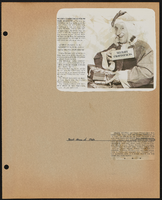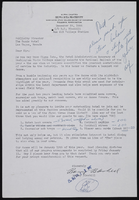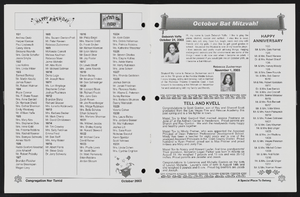Search the Special Collections and Archives Portal
Search Results

Transcript of interview with Tom Wright by Claytee White, February 14, 2005
Date
Archival Collection
Description
Dr. Tom Wright was born and grew up in Illinois. His father finished his PhD in Chicago and then taught at Illinois College in Jacksonville. His mother suffered from arthritis and was told to seek a warmer climate, so John Wright packed up his family and moved to Las Vegas. Tom was 14, ready for high school, and his two brothers were elementary school age. Tom attended Las Vegas High School, which was close to the Crestwood community where the family had purchased their first home. He remembers that UNLV had no buildings when his dad first started teaching there. Instead, he conducted class in high school classrooms and church Sunday school rooms. Dr. Wright started off at a community college as a Geology Major, but a class with Bud Poland convinced him that history was his passion. He transferred to Pomona to continue his bachelor's degree. He spent his junior year in Peru on a study-abroad program, and that experience made him a Latin Americanist. The information he gath
Text
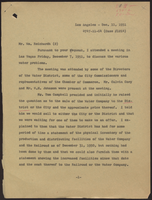
Letter from E. E. Bennett (Los Angeles) to William Reinhardt, December 11, 1951
Date
Archival Collection
Description
The Las Vegas Land and Water Company provided the water district with an inventory a year before, but no buyers made an offer yet. The letter is an account of a meeting to discuss further details of the proposed purchase. "8011-- 174-2 80-Gen." written in red pencil at head of the letter.
Text
Charles Adams oral history interview
Identifier
Abstract
Oral history interview with Charles Adams conducted by Mike Lommori on February 28, 1980 for the Ralph Roske Oral History Project on Early Las Vegas. In this interview, Adams discusses the changes in Southern Nevada over the previous twenty years. The two discuss, more specifically, changes at the University of Nevada, Las Vegas over several years and the way student life has evolved. Adams also discusses some of the differences between Las Vegas and Joliet, Illinois, and changes in the gaming industry.
Archival Collection
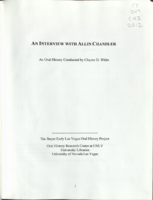
Transcript of interview with Allin Chandler by Claytee White, February 5, 2013
Date
Archival Collection
Description
Another member of Rancho High School's first graduating class of 1962, Allin Chandler charted a course that took him from school football to a distinguished career as a teacher, principal, and Executive Director for the Clark County Association of School Administrators. Allin moved to Las Vegas from Texarkana, Texas with his mother in 1958, joining his father who was serving in the Air Force and stationed at Nellis AFB. Starting 9th grade at J.D. Smith Junior High and continuing on to Rancho the following year. Still actively involved in school athletics, Allin quickly discovered his talent and love for maths and science and eventually earned his degree in math and education. The stories Allin shares in this interview paint a vivid picture of how an intelligent and motivated young man can succeed - and how the class-free world of Las Vegas in the 1950s and 60s offered opportunities that he would never have had in class-conscious world of the South.
Text
Steven Kwon oral history interview
Identifier
Abstract
Oral history interview with Steven Kwon conducted by Stefani Evans on October 1, 2024 for the Reflections: the Las Vegas Asian American and Pacific Islander Oral History Project. In this interview, Kwon begins by describing his childhood in Seoul, Korea as the youngest of three children during the Korean conflict. In 1960, he served his compulsory military service, which was 18 months for students. In 1964, he followed a friend's recommendation to go to Denmark and attend the folk high school (now the International People's College) to immerse himself in the Danish language, history, and community. He spent one year at the folk high school and later attended the College of Building Technology at the University of Denmark. While he was in his final year, Las Vegas, Nevada architect James McDaniel recruited him to join his firm, which he did in December 1974. After working with McDaniel for one year, he joined Jack Miller Associates for three years and David Welles/Architronics before opening his own design/build firm, GKG Builders in 1986, which he claims was the first Las Vegas firm to offer both services. Soon after arriving in Las Vegas, he joined the Lions Club and Rotary International and, in 1986 created Southern Nevada's first Asian Chamber of Commerce. He also worked with various politicians at different levels of government to encourage South Korean investment in Las Vegas and Nevada, eventually forming a sister-city relationship between Las Vegas, Nevada, and An San, Korea. Lastly, Kwon recalls how he came to design and build the International Peace Education Center (IPEC) on Bermuda Road for the Reverend Sun Myung Moon, founder of the Unification Church, shortly before Moon passed away.
Archival Collection

